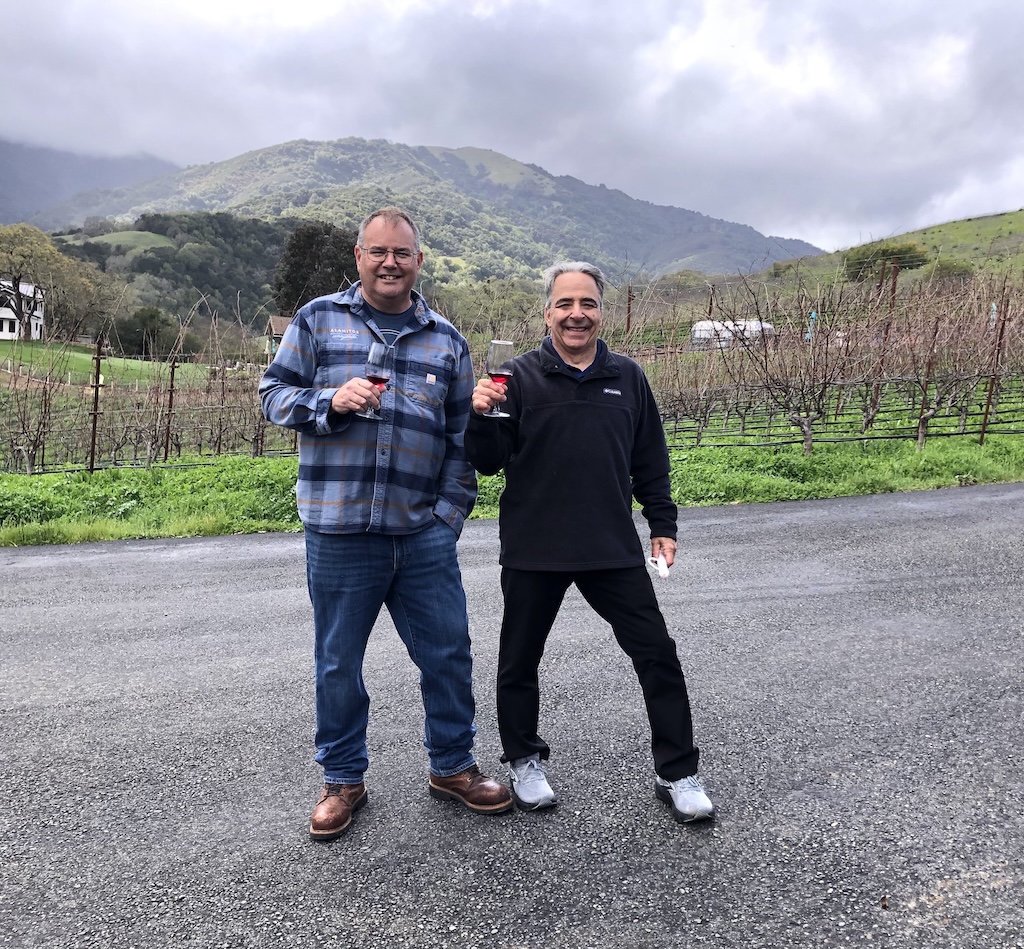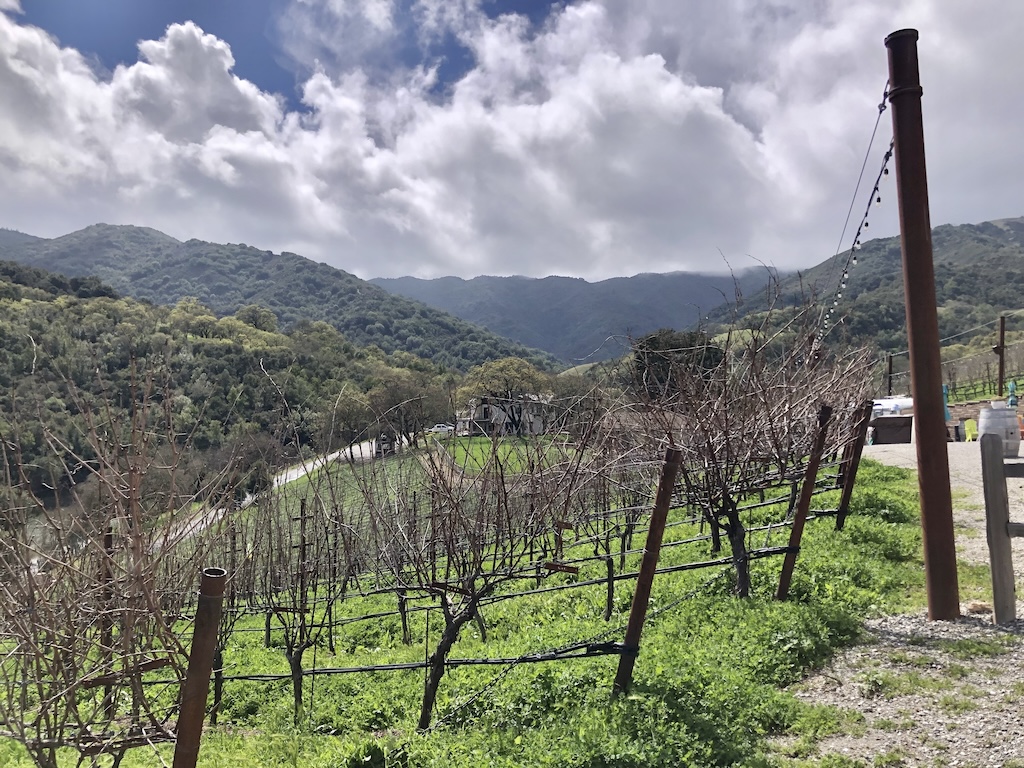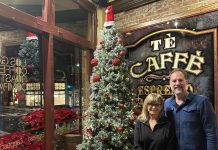Every St. Patrick’s Day, I’m reminded of the enormous fun our high school had putting on the musical “Finian’s Rainbow.”
The music was lively. The sets featured a luminous rainbow and a huge pot spilling over with goofy looking gold. The costumes were even goofier, and it was a hoot listening to my classmates trying to spoof Irish accents.
This St. Patrick’s Day, with unsettled weather and a cool breeze, proved ideal for rainbow-watching in the emerald hills along the Almaden Reservoir.
My destination was Alamitos Vineyards, perched in the steep terrain adjacent to Quicksilver Park.
Alamitos Vineyards owner Shaun Coleman and winemaker George Troquato, who made wine for Cinnabar for decades, had invited me to check out the 2024 whites they were about to bottle, along with the 2023 pinot noir. Barrel tasting is a privilege that really helps you hone your sensory skills. Also, it sharpens your prediction abilities, as you try to project how a wine will evolve. The basic premise is, if it tastes pretty darn good right now, has no rough edges or attitudes—and wouldn’t benefit from more snooze time on the barrel—then it’s time to bottle.
Planted in 2015 and opened in 2021, Alamitos Vineyards is the agricultural passion project of proprietors Shaun Coleman and Chris Maune. They’re tech entrepreneurs who’ve built several companies, and who have family histories that include farming. Coleman’s Portuguese heritage led him to plant touriga nacional, from which they make rosé. His grandfather made wine in Livermore Valley, for Cresta Blanca, Concannon and Wente. Maune’s grandfather and father were Iowa soybean and wheat farmers.
Each year, the two have learned important, if sometimes painful, lessons about grape-growing. Their six-acre vineyard is planted to sauvignon blanc, which is along the bottom of the property—influenced by the chilly breeze off the reservoir. Syrah and touriga nacional inhabit the warmer upslope. The couple purchased the parcel—including several residences tucked among majestic live and blue oaks, surrounded by a velvety lush lawn—in 2014, from owners who used the property for weddings and events.
In the shadowed light that played between the ominous dark clouds to the west, the cover crop between the sauv blanc vineyard rows practically glowed with different shades of green. “Vineyards are a monoculture,” explained Troquato. “Planting a mix of seeds for the cover crop creates biodiversity, adds nutrients to the soil, attracts beneficial insects and helps the vines grow stronger. All these clovers, legumes and burdock help build the soil. We won’t till it or mow it, but just let it naturally become absorbed.”
Troquato says the vineyard is getting healthier each year, through proper pruning and soil amendments. Healthier vineyards yield better wine. And, yes, you can taste the difference.

With the wind driving raindrops sideways from the spitting clouds above, we tasted from the steel and wood barrels inside one of the many refrigerated railroad cars that’ve been turned into storage sheds.
First up: a dawn pale rosé of albarino, touriga and syrah, with a welcoming perfumey nose of fresh rhubarb and rose petals. The Albarino delivers nectarine and lime on the palate, while the syrah adds a bit of grip, and the touriga leaves the impression of a fruit hard candy on the finish. It’s fresh and lively and enormously tasty, and I must admit most of it landed on my boots when I dumped it out, just as the wind whipped around from the north. This job does have its perils.
The 2024 estate sauvignon blanc is a confluence of two styles: fumé, which is overtly oak influenced, and pure stainless—with zero oak. The former is associated with Napa, while the latter is the winning formula of New Zealand. Not a fan of either, but preferring to marry the two approaches, Troquato says, “We went for the middle. We’re not looking for oak flavors per se. Just the texture.” The candied pineapple melds with stonefruit, kiwi and papaya for a lovely compromise.
Their very first chardonnay comes from the Tondre Grapefields in the Santa Lucia Highlands. Neither Coleman or Maune even like chardonnay, and didn’t plant it. But they disappointed far too many chard lovers who won’t drink any other white. So, they resolved to add this to the portfolio. Opening with nice orchard fruit on the creamy palate and finishing with more than a hint of toasty oak should please those who like the California sunshine style of chardonnay.
It began to rain more decidedly as we headed down the hill to the trailer where the reds rested in their barrels. Troquato wanted me to try three different samples of the same pinot noir. All were 2023 pinot noir from the Tondre Grapefields, the same source as the chardonnay.
The first barrel sample had a distinctive rose petal and strawberry aroma, with vivid red current, red raspberry and pretty red cherry on the palate. A hint of tarragon and lavender kept it fresh and exciting. Barrel #2 was more nuanced and delicate, with lovely incense, sandalwood and orange peel. Its elevated acid and citrus drive kept it zinging in my head. The third sample was a little simpler, tasting of strawberry soda, with a bit of skin tannin on the finish.
Each was intriguing in its own right, with the second sample seeming to stand apart. Perhaps they’ll all be blended together. Maybe they’ll bottle the #2 barrel on its own, to provide club members two different experiences.
“We want the absolute best wine we can make: we can’t afford to make mediocre wine,” Troquato says, with Coleman affirming. “If you are going to be a winery, why not make the best wine possible?”










